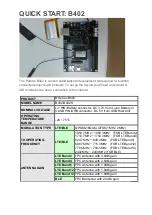Chapter 36 Nexus Development Interface (NDI)
MPC5602P Microcontroller Reference Manual, Rev. 4
872
Freescale Semiconductor
36.7
Memory map and registers description
The NDI block contains no memory-mapped registers. Nexus registers are accessed by a development tool
via the JTAG port using a client-select value and a register index. OnCE registers are accessed by loading
the appropriate value in the RS[0:6] field of the OnCE command register (OCMD) via the JTAG port.
36.8
Interrupts and Exceptions
The Power Architecture technology defines the mechanisms by which the e200z0h core implements
interrupts and exceptions. The document uses the terminology
Interrupt
as the action in which the
processor saves its old context and begins execution at a predetermined interrupt handler address.
Exceptions
are referred to as events, which when enabled, will cause the processor to take an interrupt.
This section uses the same terminology.
The Power Architecture exception mechanism allows the processor to change to supervisor state as a result
of unusual conditions arising in the execution of instructions, and from external signals, bus errors, or
various internal conditions. When interrupts occur, information about the state of the processor is saved to
machine state save/restore registers (SRR0/SRR1, CSRR0/CSRR1, or DSRR0/DSRR1) and the processor
begins execution at an address (interrupt vector) determined by the Interrupt Vector Prefix register (IVPR),
and one of the hardwired Interrupt Vector Offset values. Processing of instructions within the interrupt
handler begins in supervisor mode.
Multiple exception conditions can map to a single interrupt vector, and may be distinguished by examining
registers associated with the interrupt. The Exception Syndrome register (ESR) is updated with
information specific to the exception type when an interrupt occurs.
To prevent loss of state information, interrupt handlers must save the information stored in the machine
state save/restore registers, soon after the interrupt has been taken. Three sets of these registers are
implemented; SRR0 and SRR1 for non-critical interrupts, CSRR0 and CSRR1 for critical interrupts, and
DSRR0 and DSRR1 for debug interrupts (when the Debug APU is enabled). Hardware supports nesting
of critical interrupts within non-critical interrupts, and debug interrupts within both critical and non-critical
interrupts. It is up to the interrupt handler to save necessary state information if interrupts of a given class
are re-enabled within the handler.
The following terms are used to describe the stages of exception processing:
•
Recognition—Exception recognition occurs when the condition that can cause an exception is
identified by the processor. This is also referred to as an exception event.
•
Taken—An interrupt is said to be taken when control of instruction execution is passed to the
interrupt handler; that is, the context is saved and the instruction at the appropriate vector offset is
fetched and the interrupt handler routine begins.
•
Handling—Interrupt handling is performed by the software linked to the appropriate vector offset.
Interrupt handling is begun in supervisor mode.
Returning from an interrupt is performed by executing an
se_rfi
,
se_rfci
, or
se_rfdi
instruction to restore
state information from the respective machine state save/restore register pair.


















